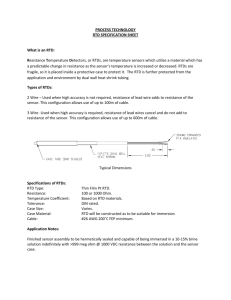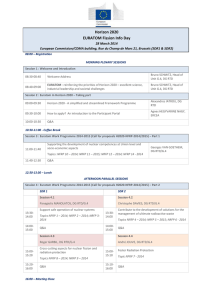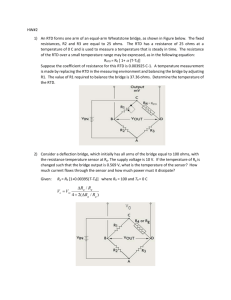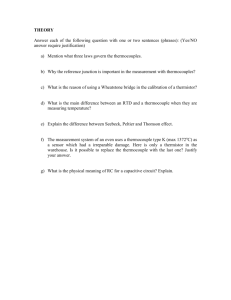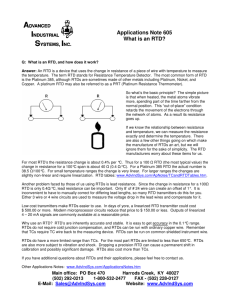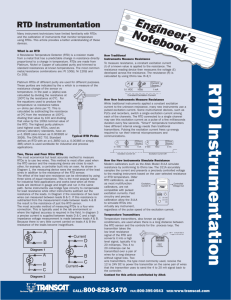Minimizing Errors in
advertisement
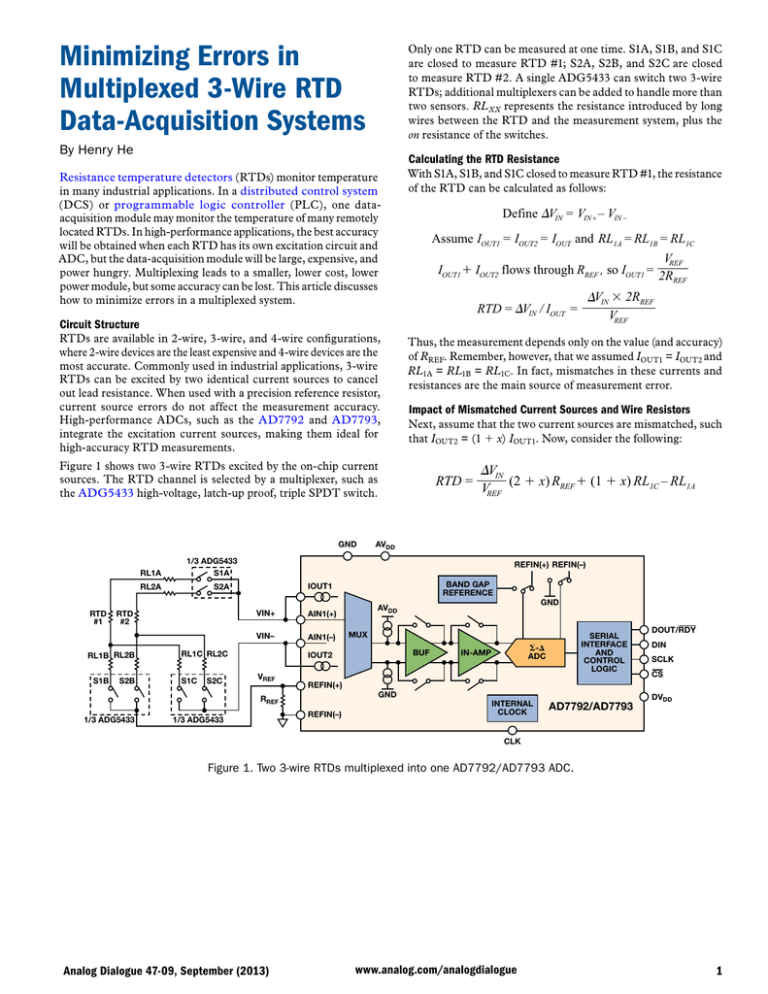
Minimizing Errors in Multiplexed 3-Wire RTD Data-Acquisition Systems Only one RTD can be measured at one time. S1A, S1B, and S1C are closed to measure RTD #1; S2A, S2B, and S2C are closed to measure RTD #2. A single ADG5433 can switch two 3-wire RTDs; additional multiplexers can be added to handle more than two sensors. RL XX represents the resistance introduced by long wires between the RTD and the measurement system, plus the on resistance of the switches. By Henry He Calculating the RTD Resistance Resistance temperature detectors (RTDs) monitor temperature in many industrial applications. In a distributed control system (DCS) or programmable logic controller (PLC), one dataacquisition module may monitor the temperature of many remotely located RTDs. In high-performance applications, the best accuracy will be obtained when each RTD has its own excitation circuit and ADC, but the data-acquisition module will be large, expensive, and power hungry. Multiplexing leads to a smaller, lower cost, lower power module, but some accuracy can be lost. This article discusses how to minimize errors in a multiplexed system. With S1A, S1B, and S1C closed to measure RTD #1, the resistance of the RTD can be calculated as follows: Define VIN = VIN+ – VIN – Assume IOUT1 = IOUT2 = IOUT and RL1A = RL1B = RL1C VREF IOUT1 + IOUT2 flows through RREF , so IOUT1 = 2R REF Circuit Structure RTDs are available in 2-wire, 3-wire, and 4-wire configurations, where 2-wire devices are the least expensive and 4-wire devices are the most accurate. Commonly used in industrial applications, 3-wire RTDs can be excited by two identical current sources to cancel out lead resistance. When used with a precision reference resistor, current source errors do not affect the measurement accuracy. High-performance ADCs, such as the AD7792 and AD7793, integrate the excitation current sources, making them ideal for high-accuracy RTD measurements. Thus, the measurement depends only on the value (and accuracy) of R REF. Remember, however, that we assumed IOUT1 = IOUT2 and RL1A = RL1B = RL1C. In fact, mismatches in these currents and resistances are the main source of measurement error. Impact of Mismatched Current Sources and Wire Resistors Next, assume that the two current sources are mismatched, such that IOUT2 = (1 + x) IOUT1. Now, consider the following: Figure 1 shows two 3-wire RTDs excited by the on-chip current sources. The RTD channel is selected by a multiplexer, such as the ADG5433 high-voltage, latch-up proof, triple SPDT switch. GND RL1A RTD #1 S1B S2B AVDD VIN+ AIN1(+) VIN– AIN1(–) RL1C RL2C S1C S2C BAND GAP REFERENCE IOUT1 VREF REFIN(+) 1/3 ADG5433 REFIN(–) GND AVDD MUX BUF IOUT2 RREF 1/3 ADG5433 VIN (2 + x) RREF + (1 + x) RL1C – RL1A VREF REFIN(+) REFIN(–) S2A RTD #2 RL1B RL2B RTD = 1/3 ADG5433 S1A RL2A VIN × 2RREF VREF RTD = VIN / IOUT = GND SERIAL INTERFACE AND CONTROL LOGIC 𝚺-𝚫 ADC IN-AMP INTERNAL CLOCK AD7792/AD7793 DOUT/RDY DIN SCLK CS DVDD CLK Figure 1. Two 3-wire RTDs multiplexed into one AD7792/AD7793 ADC. Analog Dialogue 47-09, September (2013) www.analog.com/analogdialogue 1 Note that the mismatch creates both an offset error and a gain error. The offset error is related to the mismatch between the two lead resistances, while the gain error is related to the mismatch between the two current sources. If these mismatches are not taken into consideration, the calculated value of the RTD resistance, based on the data read from the ADC, will be incorrect. Using a 200 -Ω RTD as an example, Table 1 shows the acquired values when the mismatches are not considered, given RREF = 1000 Ω, IOUT1 = 1 mA, IOUT2 > IOUT1 by the percentage shown, RL1A = 10 Ω, and RL1C > RL1A by the resistance shown. Table 1. Measured RTD Values When Mismatches Are Not Considered RL1C – RL1A (IOUT2 – IOUT1)/IOUT1 0.01 Ω 0.1 Ω 1Ω 0.1% 199.88 199.79 198.89 0.5% 199.44 199.35 198.45 1.0% 198.90 198.81 197.90 Now, if we sum the results from a conversion with the current sources connected in the original orientation and a second conversion with the current sources swapped, the result is VIN1 + VIN2 = (IOUT1 + IOUT2 ) × (RTD + RL1A – RL1C ) = VREF (RTD + RL1A – RL1C ) RREF Consequently, RTD = VIN1 + VIN2 × RREF + RL1C – RL1A VREF Note that the measurement is now independent of current source mismatch. The only downside is the loss of speed, because two conversions are needed for each RTD calculation. The AD7792 and AD7793 are designed for this application. As shown in Figure 2, integrated switches make it easy to swap the current sources to the output pins by writing to an I/O register. Conclusion Minimizing the Errors The data shows that small mismatches will degrade the accuracy severely, and that well matched current sources and switches should be used to improve performance. The transfer function is linear, so initial errors due to current source and resistance mismatches can be calibrated out easily. Unfortunately, the mismatch varies with temperature, making it difficult to compensate. Hence, it’s important to use devices that have low drift over temperature. With IOUT1 ≠ IOUT2, and the current sources connected as shown: VIN1 = IOUT1 (RL1A + RTD) – IOUT2 × RL1C Assume we swap IOUT1 and IOUT2, so that IOUT1 now connects to VIN – and IOUT2 now connects to VIN+: VIN2 = IOUT2 (RL1A + RTD) – IOUT1 × RL1C GND AVDD Swapping the excitation current sources within the AD7792/AD7793 can improve accuracy in a multiplexed RTD measurement circuit. Calculations show the importance of mismatches between current sources and wire resistances. References Kester, Walt, James Bryant, and Walt Jung. “Temperature Sensors.” Sensor Signal Conditioning, Section 7. Analog Devices, Inc., 1999. Author Henr y He [ hen r y.he@analog.com] joined Analog Devices in 2012 as a field application engineer in Beijing, China. Prior to joining ADI, Henry worked for GE Energy and SUPCON as a hardware engineer. He received his BS and MS from Zhejiang University, both in industrial automation. REFIN(+)/AIN3(+) REFIN(–)/AIN3(–) VBIAS BAND GAP REFERENCE GND AVDD AIN1(+) AIN1(–) AIN2(+) AIN2(–) MUX BUF IOUT1 IOUT2 𝚺-𝚫 ADC IN-AMP SERIAL INTERFACE AND CONTROL LOGIC AVDD GND INTERNAL CLOCK AD7792: 16-BIT AD7793: 24-BIT DOUT/RDY DIN SCLK CS DVDD CLK SWITCHES TO CHANGE THE OUTPUT PIN OF CURRENT SOURCES Figure 2. Functional block of AD7792/AD7793. 2 Analog Dialogue 47-09, September (2013)
